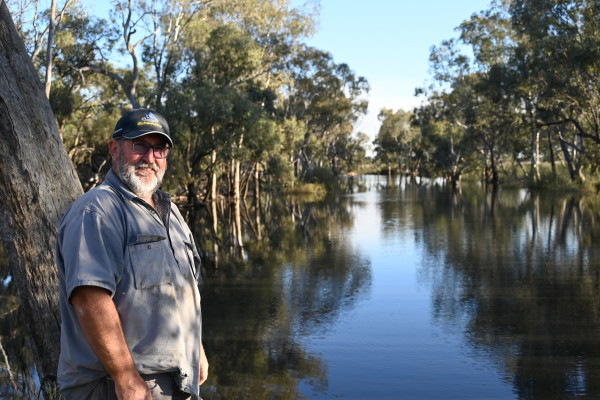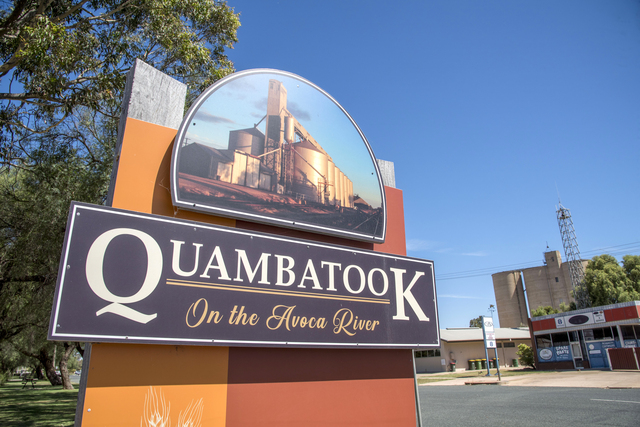A FEW kilometres south of Kerang, a new wetland is already teeming with life.
Less than a month ago, around 135 megalitres of water was pumped into two ephemeral flood runners that stretch across roughly one kilometre on Dale Trevorrow’s farm.
Mr Trevorrow bought the property in 1996, and after observing the creek beds fill multiple times during floods and high rivers, the irrigation and livestock farmer realised how special the site could be as an ecological wetland.
After years of negotiating with different levels of state and federal government, the environmental water trust allocation was given the green light.
Mr Trevorrow said the results were stunning and immediate.
“We started filling this just three weeks ago, and the draw of birdlife was almost instantaneous,” he said.
“We had kingfishers, fairy wrens, Australian ringnecks – and hundreds of ducks: teal, wood, black ducks, mountain ducks.
“There’d be probably 300 birds and all they do is fly from one end to the other.”
Murray Darling Wetlands Working Group’s senior environmental water manager Sascha Healy said the site is a haven for endangered native species including several listed under the Environment Protection and Biodiversity Conservation Act of 1999.
“The flood runners on Dale’s property are former channels of the Loddon,” Ms Healy said.
“These sites are special because the landholder is dedicated, but also because the site is protected by the North Central Catchment Management Authority (CMA).
“It’s great for a multitude of wildlife water birds, ground and grass frogs, small fish.”
One of the main reasons Mr Trevorrow’s wetlands are so special for native wildlife is the abundance of lignum.
Lignum is a wiry, bushy native wetland plant that saw significant regeneration after the 2022 floods.
“The lignum regeneration we saw in 2022 was a once in a lifetime thing,” Ms Healy said.
“Places like (Mr Trevorrow’s) property is one of the only places in the state we see lignum growing from seed.
“Because it’s so thick and tangled, it’s really difficult to get in there for predators.”
Since water was pumped into the flood runners, Mr Trevorrow said the lignum has burst to new life.
In just three weeks, the native bushes filled with thousands of bees.
“So anything that’s small enough to get through is safe from where birds and things can potentially pick them off,” Mr Trevorrow said.
In spring, the North Central CMA will introduce several species of endangered fish including the native southern purple-spotted gudgeon.
The southern purple-spotted gudgeon, dubbed “zombie fish”, were declared extinct in Victoria in 1998 until two were discovered near Kerang in 2019.
Olive perchlets and the southern pygmy perch are also set to be introduced, both of which have been declining at significant rates.
The olive perchlet, which was once widespread throughout the Murray-Darling, was reintroduced to the wild for the first time in January this year.
“I don’t profess to be a greenie, I’m not doing it for any other reason that if I don’t – then where are these little fish going to breed?” Mr Trevorrow said.
“The whole thing is a self-contained ecosystem. It’s a habitat that’s locked away; people can’t get in and poach in it.
“We had a choice of what we could put in there, the North Central CMA were asking whether we wanted catfish or river blackfish.
“But I think the little guys need a big of a go – somewhere where they’re a bit protected.”
Mr Trevorrow and the team of environmentalists who helped create the wetland have put significant effort into keeping European carp out.
Where the water feeds from Mr Trevorrow’s irrigation channels into the flood runners, a dam has been created.
“It’s fairly shallow here, and we’ve set up a mass of dead lignum and dirt and whatever else to hold it together so the bigger fish can’t penetrate it,” Mr Trevorrow said.
“The water then filters through a low-lying grassy marshland before entering the creeks.”
Throughout the two creeks, Mr Trevorrow has placed several hollowed-out logs, blocks of concrete and other places for the little fish to hide.
The creeks are connected by a 450ml pipe, meaning Mr Trevorrow is able to regulate the amount of water in the second creek, and even if European carp make it through into the first creek the second is safe.
“When we get the next flood and all this fills up, obviously we’re going to have an influx of European carp and cod and redfin and everything.
“So then we’ve got the opportunity to open the doors and drain the whole system out.
“And the little fish that do survive are flushed back into the natural environment and hopefully enough of them have bred that they’ve got a chance.”
Ms Healy said such conservation efforts wouldn’t be possible without people like Mr Trevorrow.
“Dale was the protagonist, the lead actor,” Ms Healy said.
“He approached us because he wanted some water, so there’s a keen landholder and good site protections.
“Even if the CMA didn’t come along to put the fish in, this site is incredibly special for all different kinds of endangered native wildlife.”
Mr Trevorrow said “it’s not about being green.”
“It’s about looking after what’s here. A local guy once said to me he wanted to leave his farm in a better situation to his kids than when he got it,” Mr Trevorrow said.
“To me, this is a classic example of that: if I can make it a better place for my kids, my grandkids and we can come and enjoy what we are now.
“Hopefully the little fish have done their thing too; if we can assist in some way in bringing something back from extinction, then that’s alright.”







